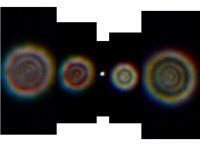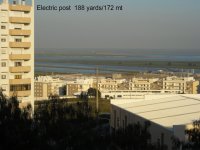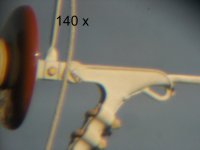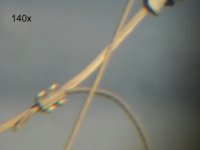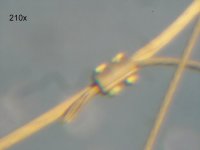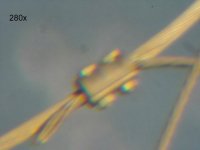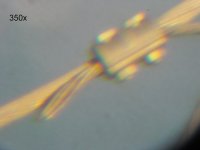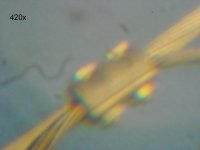henry link
Well-known member
Maybe I shouldn't have mentioned star testing. It's a useful tool, but easily misinterpreted. Here are some of the things to look for.
The star test images below show the second Zen-Ray scope I was sent. As an experiment I star tested it with the aperture stopped down to 35mm to eliminate the contribution to aberrations and defects from the outside 60% of the objective. The series of photos moves from 3 rings outside of focus on the left through focus in the center to about 3 rings inside of focus on the right. Except for the smeary spectrum of color it shows a very respectable looking test. There is good (but not perfect) symmetry in the appearance of the rings inside and outside of focus indicating good spherical correction. The flat spot at 4:00 and the astigmatism in the full aperture test are essentially gone. It's very unlikely that any specimen of this scope would look this good at full aperture, but from these images you can get a sense of what you would like to see (except for the color). Departures from this pattern indicate that something is wrong. Astigmatism causes the circles to become ovals, pinching may deform the circles in unpredictable ways, coma will cause an offset of the center of the rings, spherical aberration cases the rings to appear weaker on one side of focus than the other and there are other less common faults.
I should mention that the star test is very sensitive. Almost every scope shows some faults, so don't panic if the test is not perfect. It won't be.
The star test images below show the second Zen-Ray scope I was sent. As an experiment I star tested it with the aperture stopped down to 35mm to eliminate the contribution to aberrations and defects from the outside 60% of the objective. The series of photos moves from 3 rings outside of focus on the left through focus in the center to about 3 rings inside of focus on the right. Except for the smeary spectrum of color it shows a very respectable looking test. There is good (but not perfect) symmetry in the appearance of the rings inside and outside of focus indicating good spherical correction. The flat spot at 4:00 and the astigmatism in the full aperture test are essentially gone. It's very unlikely that any specimen of this scope would look this good at full aperture, but from these images you can get a sense of what you would like to see (except for the color). Departures from this pattern indicate that something is wrong. Astigmatism causes the circles to become ovals, pinching may deform the circles in unpredictable ways, coma will cause an offset of the center of the rings, spherical aberration cases the rings to appear weaker on one side of focus than the other and there are other less common faults.
I should mention that the star test is very sensitive. Almost every scope shows some faults, so don't panic if the test is not perfect. It won't be.
Attachments
Last edited:




